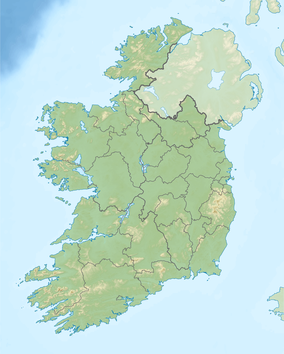The Wicklow Reef (Irish: Sceir Cill Mhantáin) is a shallow subtidal reef in the Irish Sea, located off the coast of County Wicklow, Ireland, approximately 2.88 kilometres (1.79 mi) northeast of Wicklow Head. The reefs are constructed by the honeycomb worm (Sabellaria alveolata) and are located at a depth of 12 to 30 metres (39 to 98 ft).[1]
| Wicklow Reef | |
|---|---|
| Sceir Cill Mhantáin | |
| Location | County Wicklow, Ireland |
| Coordinates | 52°58′25″N 5°57′25″W / 52.9736°N 5.95683°W |
| Area | 3,790 acres (15.3 km2) |
| Designation | Special Area of Conservation |
| Governing body | National Parks and Wildlife Service |
Prior to the discovery of the Wicklow Reef in 1997, Sabellaria alveolata reefs were only known to occur in inter-tidal zones along the coasts of Britain and Ireland. Sub-tidal reefs are exceptionally rare in the region, being typically found in the Mediterranean. The Wicklow Reef is the first and only known example of a sub-tidal Sabellaria alveolata reef off the coast of Britain and Ireland.[2]
The reef is home to a number of species of crab, starfish, sea-squirts, brittlestars, as well as molluscs and bryozoans. Several species of worm such as Phaeostachys spinifera, Eulalia ornata and Unciola crenatipalma are very uncommon in Irish waters, and the Wicklow Reef is therefore considered a priority habitat. The reef is an EU-designated Special Area of Conservation.[3]
Reef species
edit| Scientific Name | Image |
|---|---|
| Sabellaria alveolata | |
| Spirobranchus triqueter | |
| Urticina felina | |
| Tubularia indivisa | |
| Ophiothrix fragilis | |
| Sertularia argentea | |
| Clavelina lepadiformis | |
| Hydrallmania falcata |
See also
editReferences
edit- ^ "Wicklow Reef SAC - Site Synopsis" (PDF). National Parks and Wildlife Service. Retrieved 14 May 2022.
- ^ "Wicklow Reef SAC - Conservation objectives supporting document" (PDF). National Parks and Wildlife Service. Retrieved 14 May 2022.
- ^ "Factsheet - Wicklow Reef SAC". European Environment Agency. Retrieved 14 May 2022.
